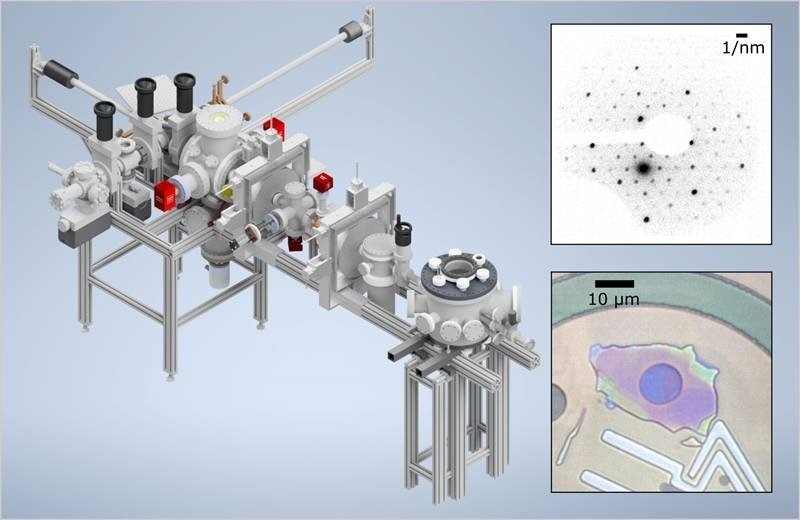Quantum materials possess a wide range of exciting electronic, magnetic, and optical characteristics, making them ideal candidates for application in future computer and energy systems.
 The new ultrafast electron probe apparatus is 3 meters long (left). The diffraction pattern (top right) encodes detailed information on the positions of the atoms within a small sample flake (bottom right). Image Credit: Cornell University
The new ultrafast electron probe apparatus is 3 meters long (left). The diffraction pattern (top right) encodes detailed information on the positions of the atoms within a small sample flake (bottom right). Image Credit: Cornell University
Their features are the result of a complicated interplay between electrons and atomic nuclei. Using brief bursts of X-rays or electron beams, researchers can investigate these interactions in real-time. These pulses have a duration of less than a trillionth of a second. Researchers devised an ultrafast electron beam approach to probe small, thin portions of quantum materials with very high resolution using novel materials that emit a narrow electron probe.
The Impact
So far, scientists have been unable to produce several newly developing quantum materials as massive crystals. Instead, these materials create crystals that are only a hundredth the width of a human hair. This presents a difficulty for researchers utilizing ultrafast electron beam accelerators to probe these materials, as electron beam quality frequently restricts how small an area these beams can concentrate on.
The researchers in this study employed a customized electron source to create a significant increase in electron beam quality. This allows for detailed images of samples as small as a few microns across and operations that happen in less than a trillionth of a second. This research might lead to a better picture and understanding of how quantum materials act at the atomic space and temporal scales.
Summary
These accelerators often produce ultrafast electron pulses by a process known as photoemission, in which laser light knocks electrons out of a material, typically a simple metal such as copper. If the laser pulse is brief, the produced electron beam will be brief as well.
The electrons generated by standard photoemission sources do not all move in the same direction, which presents a hurdle. This variation in emission angle could eventually limit researchers’ capacity to focus an electron beam on a small area.
Researchers created a photoemission-based electron accelerator using an improved, in-house generated photoemission material that generates many electrons with a considerably lower dispersion in emission angle.
The researchers used this source in combination with precision electron-focusing optics to undertake proof-of-principle ultrafast electron diffraction studies that demonstrated the capacity to discern fine atomic features in materials as tiny as a few microns in size.
Journal Reference:
Li, W. H., et al. (2023) A kiloelectron-volt ultrafast electron micro-diffraction apparatus using low emittance semiconductor photocathodes. Structural Dynamics. doi:10.1063/4.0000138